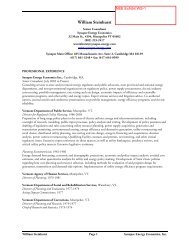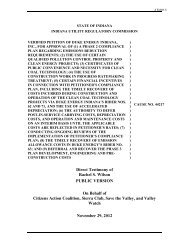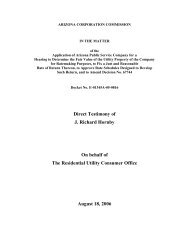Best Practices in Energy Efficiency Program Screening - Synapse ...
Best Practices in Energy Efficiency Program Screening - Synapse ...
Best Practices in Energy Efficiency Program Screening - Synapse ...
Create successful ePaper yourself
Turn your PDF publications into a flip-book with our unique Google optimized e-Paper software.
6. Summary of Recommendations<br />
Here we provide a summary of the recommendations made above. We recognize that<br />
most states have an established set of practices that have been developed with<br />
considerable effort and stakeholder <strong>in</strong>put over time, and that some states might have<br />
good reasons for adopt<strong>in</strong>g an approach that is different than what makes sense for other<br />
states. Nonetheless, we urge regulators and other stakeholders to consider these<br />
recommendations as opportunities to improve upon current practices where appropriate.<br />
Tests for Screen<strong>in</strong>g <strong>Energy</strong> <strong>Efficiency</strong> <strong>Program</strong>s<br />
We recommend that the Societal Cost test be used to screen energy efficiency<br />
programs. If a state chooses to use the Societal Cost test, the test should account for<br />
utility- participant- and societal-perspective OPIs to the greatest extent possible.<br />
We recommend that all states that choose not to rely on the Societal Cost test use the<br />
TRC test to screen energy efficiency programs. If a state chooses the TRC test, the test<br />
should account for OPIs to the greatest extent possible.<br />
If regulators are unwill<strong>in</strong>g to account for OPIs, the TRC test should not be used for<br />
screen<strong>in</strong>g energy efficiency programs. In the absence of participant OPIs, the PAC test<br />
is the best test to use <strong>in</strong> screen<strong>in</strong>g energy efficiency.<br />
We recommend that the PAC test be applied to the entire portfolio of efficiency<br />
programs, to ensure that the entire portfolio of programs will result <strong>in</strong> a net reduction <strong>in</strong><br />
revenue requirements and a net reduction <strong>in</strong> costs to utility customers.<br />
The RIM test should not be used <strong>in</strong> screen<strong>in</strong>g energy efficiency programs for costeffectiveness.<br />
Instead, efficiency program adm<strong>in</strong>istrators should take steps to<br />
(a) analyze rate and bill impacts <strong>in</strong> a fashion that provides much more <strong>in</strong>formation than<br />
what is available from the RIM test; (b) design programs <strong>in</strong> a way that mitigates rate<br />
impacts without sacrific<strong>in</strong>g energy efficiency sav<strong>in</strong>gs; and (c) work to <strong>in</strong>crease the<br />
number of program participants so as to mitigate the equity concerns between<br />
participants and non-participants.<br />
<strong>Best</strong> <strong>Practices</strong><br />
Regardless of which test is used, it is crucial that states apply the cost-effectiveness<br />
tests appropriately. Accord<strong>in</strong>gly, we recommend the follow<strong>in</strong>g best practices designed<br />
to ensure that tests are implemented <strong>in</strong> a way that achieves the underly<strong>in</strong>g objective of<br />
the test, is <strong>in</strong>ternally consistent, accounts for the full value of energy efficiency<br />
resources, and uses appropriate plann<strong>in</strong>g methodologies and assumptions. These<br />
practices <strong>in</strong>clude the follow<strong>in</strong>g.<br />
Calculation of Avoided Costs<br />
Avoided energy and capacity costs should be based on long-term forecasts that properly<br />
capture the energy and capacity impacts of energy efficiency resources, account for the<br />
structure of the market <strong>in</strong> which the relevant utility operates, and captures differences <strong>in</strong><br />
hourly and seasonal peak periods.<br />
| 58 <strong>Best</strong> <strong>Practices</strong> <strong>in</strong> <strong>Energy</strong> <strong>Efficiency</strong> <strong>Program</strong> Screen<strong>in</strong>g | www.nhpci.org







